Hi you all!
Due to several questions from students, I’m creating this new discussion about diminished.
Please post any question you have to this discussion so we can start a productive conversation!
Thanks,
-Tuomo
Hi you all!
Due to several questions from students, I’m creating this new discussion about diminished.
Please post any question you have to this discussion so we can start a productive conversation!
Thanks,
-Tuomo
Here videos on the subject:
Please post any question you have to this discussion so we can start a productive conversation!
Thanks,
-Tuomo
Hi Tuomo and @Hayden and @Pierrot, could you post an explanation about the difference between the following scales : half/whole, whole/half, V7alt, and diminished 7 scales. There appear to be small, but important differences between them and I wondered about that. Do they all come from Melodic Minor scales ?
Many thanks
Natasha
Hi @natasha0412, thanks for writing!
First, diminished scale is not directly related to melodic minor, or in a matter a fact to any other scale either (of course deep down EVERYTHING in harmony is connected).
You could think the diminished scale as a connective piece and a foundation to all that works as a tension, in other words dominant (or 25).
I would not think of half/whole, whole/half scales as a different thing, in the end there are only 3 different diminished scale; one starting from the not C, one from Db and one from D (after D there would be Eb which of course is the same as the scale starting form C etc.)
So, the important thing is to understand the connection to the dominant chord and to the 25.
For example, let’s take C dim chord:

If you look at these notes, you realize they actually create F7b9 chord:

One way to think about the rest of the notes in the C diminished scale is to consider them as chromatic approach notes to the actual dim chord; B to C, D to Eb, F to Gb and Ab to A.
Another way is to think of it as the 2 chord of the 25, which of course is C-7.
Now if you look again, the C diminished scale start with 4 notes of Cminor scale:

continuing with 4 notes from the minor scale tritone away (remember, tritone is connecting things in many level, being the building block of diminished), in this case Gb (or F#) minor

This is how the 2 chord of the 25 (C-7 F7) can help understand the dim scale.
Like I mentioned earlier, there is no use of making things more complicated by thinking diminished scale as 2 different things (half/whole whole/half) when it actually is just one thing, and we can ALWAYS trace the function of any diminished scale/chord to a dominant, and to a 25.
I hope this helped, please let me know if you have any further questions!
-Tuomo
Hi @Tuomo and thanks again opening this discussion !
nice idea about the diminished scales just a approach of the diminshed chord tones of the diminished chords even it works only ascending (creating the whole half scales =Wh alias diminished scale )
when descending the approach of those chords tones creates the half-whole scales =hW
this is one thing that get me confusing
both half whole and whole half sounding great for my ears on a diminished chord just different colors
Can you help me separating and finding quicker which scales on which chords and connecting hW and Wh scales
C Wh ( same than Ebdim Gbdim Adim ) = Db hW scales on Cdim chord which could function as A7b9 or passing chord to B or C#
We could add for the view of the diminished scale Wh ( @Jovino talk somewhere the shadow chord ) as two diminihed chords stacked together Cdim and Bdim = Ddim = Abdim= Bdim
so the Cdim can be played on those 4 last chords too but either a very different colors than on Cdim(Ebdim,Gbdim ,Adim)
i am total lost 

 please help
please help 

Hi @natasha0412
The whole-half and diminished scale is the same thing
The altered chord and the half-whole scales are color scale for dominant chords (the only difference btw them are the 3 last notes G A Bb for Wh ,Ab Bb C for altered in C key) . Some name the half-whole scale the " dominant diminished scale" because this relation with dominant chords . Is that what you named diminished 7 scales ?
All these names add a little more confusion, don’t they? 
hope it helps
Hi @Pierrot,
I think you’re overthinking it 
Try to find the dominant behind every dim chord, that will help you to hear how the dim chord should function in the relation to the harmony.
there are only 3 options diminished can appear in tonal music:
Cdim (which can funtion as a B7, D7, F7 and/or Ab7

C7b9
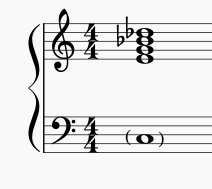
and Ddim/C (which of course is just G7 with the tonic root C in the bass, deriving from the Barry Harris voicings!)
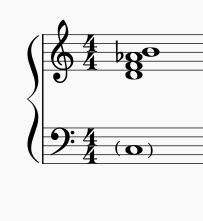
The point of the 2 diminished chords put together come just form the same diminished scale: Let’s take C diminished chord:
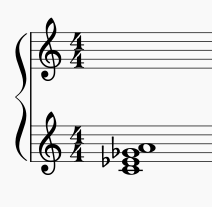
Now, if I would add all the other notes of the C diminished scale to the right hand, I would end up with a full dim chord with all the notes of the scale used (again, remember, there is only one dim scale, NO half/whole or whole/half):
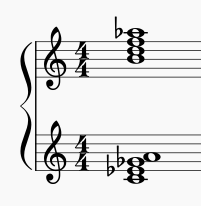
Thanks,
let me know if you have any further questions!
-Tuomo
<hi @Tuomo your answer is more about the diminished chords
but about the diminished scales and how to use it , to think it .
thanks a lot
Hello Pierre,
Thanks for your thoughtful questions regarding diminished chords and scales. @Tuomo gave some very good answers. I believe that you should play the good voicings that were suggested, plus a few other possible combinations. Remember, because of the nature of diminished chords, you can add major and minor triads that share a relationship to the root based on the scale. For instance, over a C diminished 7 chord, you can add the following major triads: D, F, Ab, B. You can also add the same tones as minor triads, and also the same tones as major or minor 6th tetrads (such as D6, Dm6, F6, Fm6, etc…) This opens up so many possibilities for chord voicing, improvising, arranging, etc. See here for some interesting suggestions of voicings for Cdim7:
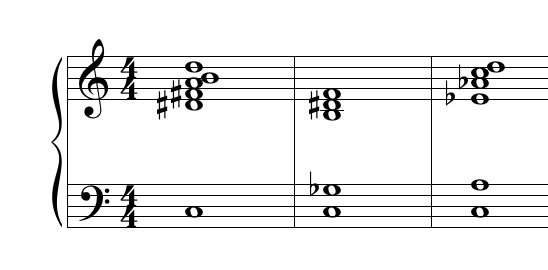
I also suggest that you study the music of Antonio Carlos Jobim, as he was a master of using diminished chords in many beautiful contexts.
Thanks for your questions, and keep playing!
Jovino
Hi @pierre,
I would not separate scales and chords from each other, as they are 100% the same thing, for example that dim chord above had all the notes from the scale.
Can I give you an assignment?
To understand diminished chord/scale function, we have to detect the dominant behind it.
Here assignment:
What dominant/dominants can be behind the following dim chord (they work as a part of the harmony):
In the key of C:
Let me know when you solve the puzzle 
Thank you so much for writing!!
Awesome voicings, and thank you for pointing out Jobim 
Also Jovino mentioned the major triads inside the diminished chord, in Cdim would be D, F, Ab, B. Now if you remember the lessons on the 4 dominants that derive from the dim chord, there they are! D7, F7, Ab7 and B7
I would have an extra question for the students about the voicings Jovino sent, which triads can you detect inside the voicings?
i would think first Eb7#9 as tritone substitution of A7 but not the 7th in it ,
so maybe more D7b9
Very good @Pierrot,
it has nothing to do with the Eb7, the key again is to find the dominant, and you are right, D7 would be the one!
The reason why Ebdim resolves to D-7 well is that the D7 is the dominant to G, in this case G7, and the D-7 is the II of the D-7 G7 II V.
Also from Ebdim you can find B7, Ab7 and F7, which can also be used to resolve to the D-7 G7 II V.
Cdim7 resolving to Cmaj.
Also explain why it resolves easily.
-Tuomo
B
B7b9 but the harmonic reason ? i dont know more than B naturally tend to go to C, as F to E in the the progression V7 to I of C
Good thinking, the reason why B7 resolves nicely to Cmaj7 is because Cmaj7 is the same thing as E-7:
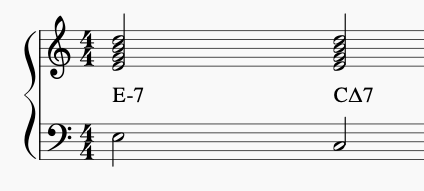
And of course B7 is the V of E-7. That is why B7 is very easy and natural to resolve to Cmaj7.
-Tuomo
Wow so easy i even dont think about it
Thanks a lot
Sorry to insist but please give some example how to apply diminished scales on a major and minor 251
i have learn the 3 half whole scale with Hayden and trying to connect it with diminished still make me headache for applying it .
in your video about diminished at 2’34 on 251 you play on a D diminished chord the D diminished so it sound ok but you subtitute Dm7 to Dm7b5 so we need to do the same when playing on 251 major and applying the diminished scale right ?
thanks a lot for your help
Lagging behind you guys trying to get my head around some of this stuff.  I came across this which is in part related. Here’s a link to videos recorded of Barry Harris at his numerous workshops at the Royal Conservatory in The Hague from 1989 till 1998. He covers a bit of everything, including diminished scales. There’s a lot to pick through, but his humorous style is worth the effort. There’s one about feeling the “and” that is interesting for his comments about how jazz was always dance music, but now it’s changed:. It’s pretty long. Most are from 2 to 15 minutes.
I came across this which is in part related. Here’s a link to videos recorded of Barry Harris at his numerous workshops at the Royal Conservatory in The Hague from 1989 till 1998. He covers a bit of everything, including diminished scales. There’s a lot to pick through, but his humorous style is worth the effort. There’s one about feeling the “and” that is interesting for his comments about how jazz was always dance music, but now it’s changed:. It’s pretty long. Most are from 2 to 15 minutes.
Here’s the link to all the videos:
Hi @Pierrot,
If you want to use diminished scale over a 25, it doesn’t matter wether the 25 is minor or major, you would be using the same Ddim scale (D E F G Ab Bb B C#)
You can think of the diminished chord/scale as another color over 25 you can use while improvising.
Let’s look at the minor 25 in C, D-7b5 is the same chord as F-6:
and the G7 would probably have for example b9 and b13 to make it sound more like going to a Cminor. So, we know that G7b9b13 is the same chord as Ab-6:
we see again that all these minor chords, D-, F- and Ab- are minor 3rd away from each other, diminished connects them.
Here’s a lesson on the subject of the minor 3rd relationship, not quite about diminished but very much connected to diminished:
I hope this helps,
let me know if you have any further questions,
-Tuomo